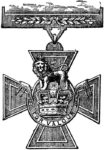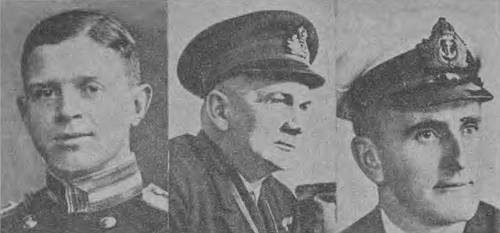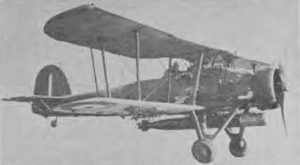- Author
- A.N. Other and NHSA Webmaster
- Subjects
- History - general
- Tags
-
- RAN Ships
- None noted.
- Publication
- December 1974 edition of the Naval Historical Review (all rights reserved)

Twenty four Victoria Crosses were won by the Navy in World War II. Eleven of the winners lived and thirteen died in the actions which won them the award. The first was won seven months after the opening of hostilities, the last in the week hostilities ended.
Capt. B. A. Warburton-Lee
As Commander of HMS Hardy and Captain (D) of the 2nd Destroyer Flotilla, Captain Warburton-Lee carried out one of the most exciting destroyer attacks of the war when he attacked a superior force of German destroyers in Narvik Fiord on the morning of 10th April 1940. In the action Hardy engaged five enemy destroyers, sinking one. Warburton-Lee was mortally wounded in the engagement.

Lt.-Cdr. Stannard of the Arab.
Lt.-Cdr. Roope of the Glowworm.
Lt-Cmdr. G. B. Roope
As commanding officer of HMS Glowworm on 8th April 1940, Lieutenant- Commander Roope fought the classic destroyer action of the war. At daybreak on that day Glowworm made contact with the German heavy cruiser Admiral Hipper in the North Sea and despite the great disparity in armament, immediately attacked. Roope fought his ship brilliantly with the object of inflicting as much damage as possible on his adversary.
When it was obvious that his ship would soon sink Roope closed the cruiser and rammed her amidships, causing damage which resulted in Hipper being recalled to Germany for repairs. Lieutenant- Commander Roope did not survive the action. Although his courageous act took place two days before Narvik, the award was not made until the end of the war.

Lt. R. B. Stannard, RNR
Lieutenant Richard Been Stannard was the first reserve officer to win the Victoria Cross and the first naval recipient to live to receive it. As commanding officer of the trawler HMS Arab at Namsos in the last week of April 1940, Lieutenant Stannard repeatedly risked his life and his ship in rescuing soldiers and sailors under furious air and ground fire. Although wounded, he continued to command Arab and successfully sailed his vessel back to England.
Acting Leading Seaman J. F. Mantle
As forward pom-pom gunner in HMS Foylebank on 4th July 1940, Leading Seaman Mantle fought off repeated attacks by enemy aircraft. Although severely wounded, he continued to fire his gun and shot down two enemy aircraft. Mantle was killed in the last attack on his ship.
Acting Capt. E. S. F. Fegen
As commanding officer of the auxiliary cruiser HMS Jervis Bay on 5th November 1940, Captain Fegen was escorting a convoy of thirty eight ships from Canada to England when the convoy was sighted by the German pocket battleship Admiral Scheer. Captain Fegen ordered the convoy to scatter, and although outgunned by the enemy, turned to attack. In the unequal action that followed, Jervis Bay was repeatedly hit and set on fire, but Fegen continued to close the enemy. Badly wounded when a shell destroyed his ship’s bridge, Fegen continued in command from the afterbridge. Although his ship was lost in the action, Fegen saved all but five of the thirty eight ships of the convoy. Captain Fegen went down with his ship.
Petty Officer A. E. Sephton
Petty Officer Sephton was stationed in a gun director tower in the anti-aircraft cruiser HMS Coventry on 18th May 1941, when that ship and HMS Phoebe were despatched to aid the hospital ship ABA under air attack off Crete. Before the cruisers could reach ABA they came under massed dive bombing attacks. Petty Officer Sephton remained at his post directing fire throughout the action. When the control tower was destroyed by a direct hit, and despite two bullet wounds, Sephton continued at his post until he died from loss of blood.
Lt-Cmdr. M. D. Wanklyn, DSO
As commanding officer of HM submarine Upholder in 1941 and early 1942, Lieutenant-Commander Wanklyn more than upheld the tradition of his chosen service. The action which won Wanklyn the coveted award culminated a career of audacity which resulted in the sinking of three U-boats, one destroyer, one armed trawler, 15 transports and supply ships, one cruiser probably sunk and one destroyer probably sunk.
The action which resulted in the award took place on the evening of 24th May 1941, just beyond the Straits of Messina. Two days previous the submarine’s asdic had been put out of action by enemy depth charge attacks. At 2030, Upholder sighted a high-speed convoy of seven or eight liners escorted by five destroyers.
To obtain the most advantageous position for attack Wanklyn took Upholder inside the escort and, although his vessel was ‘blind and deaf‘, fired a salvo of torpedoes at the middle vessel in the convoy. The submarine was immediately attacked and 37 depth charges exploded close by in 20 minutes. The ship sunk was the liner Conte Rosso.
Wanklyn’s award was announced on 11th December. Upholder sailed on her last patrol on 6th April and 12 days later Upholder and her gallant crew were destroyed by an Italian torpedo boat.




